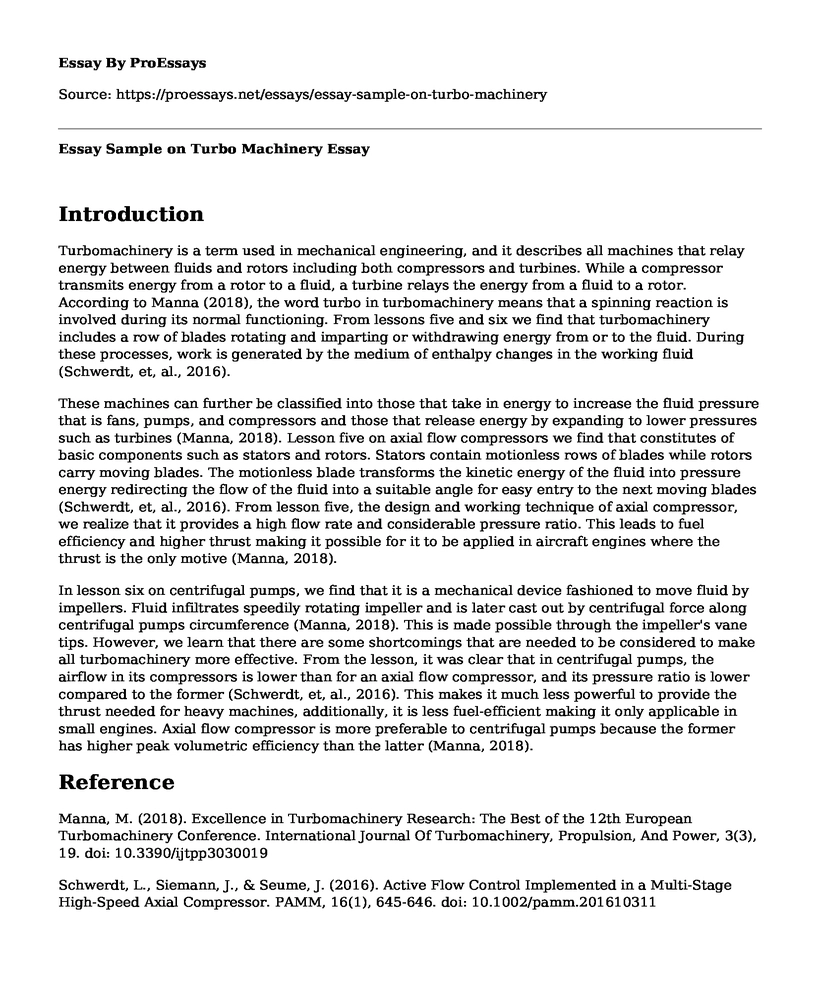Introduction
Turbomachinery is a term used in mechanical engineering, and it describes all machines that relay energy between fluids and rotors including both compressors and turbines. While a compressor transmits energy from a rotor to a fluid, a turbine relays the energy from a fluid to a rotor. According to Manna (2018), the word turbo in turbomachinery means that a spinning reaction is involved during its normal functioning. From lessons five and six we find that turbomachinery includes a row of blades rotating and imparting or withdrawing energy from or to the fluid. During these processes, work is generated by the medium of enthalpy changes in the working fluid (Schwerdt, et, al., 2016).These machines can further be classified into those that take in energy to increase the fluid pressure that is fans, pumps, and compressors and those that release energy by expanding to lower pressures such as turbines (Manna, 2018). Lesson five on axial flow compressors we find that constitutes of basic components such as stators and rotors. Stators contain motionless rows of blades while rotors carry moving blades. The motionless blade transforms the kinetic energy of the fluid into pressure energy redirecting the flow of the fluid into a suitable angle for easy entry to the next moving blades (Schwerdt, et, al., 2016). From lesson five, the design and working technique of axial compressor, we realize that it provides a high flow rate and considerable pressure ratio. This leads to fuel efficiency and higher thrust making it possible for it to be applied in aircraft engines where the thrust is the only motive (Manna, 2018).
In lesson six on centrifugal pumps, we find that it is a mechanical device fashioned to move fluid by impellers. Fluid infiltrates speedily rotating impeller and is later cast out by centrifugal force along centrifugal pumps circumference (Manna, 2018). This is made possible through the impeller's vane tips. However, we learn that there are some shortcomings that are needed to be considered to make all turbomachinery more effective. From the lesson, it was clear that in centrifugal pumps, the airflow in its compressors is lower than for an axial flow compressor, and its pressure ratio is lower compared to the former (Schwerdt, et, al., 2016). This makes it much less powerful to provide the thrust needed for heavy machines, additionally, it is less fuel-efficient making it only applicable in small engines. Axial flow compressor is more preferable to centrifugal pumps because the former has higher peak volumetric efficiency than the latter (Manna, 2018).
Reference
Manna, M. (2018). Excellence in Turbomachinery Research: The Best of the 12th European Turbomachinery Conference. International Journal Of Turbomachinery, Propulsion, And Power, 3(3), 19. doi: 10.3390/ijtpp3030019
Schwerdt, L., Siemann, J., & Seume, J. (2016). Active Flow Control Implemented in a Multi-Stage High-Speed Axial Compressor. PAMM, 16(1), 645-646. doi: 10.1002/pamm.201610311
Cite this page
Essay Sample on Turbo Machinery. (2022, Mar 09). Retrieved from https://proessays.net/essays/essay-sample-on-turbo-machinery
If you are the original author of this essay and no longer wish to have it published on the ProEssays website, please click below to request its removal:
- Personal Statement: Engineering
- Personal Statement Example: Designing and Developing a Three Phase Electrical System
- Annotated Bibliography on Building Information Model
- The Ecological Dimension of Globalization Essay Example
- Impact of Monopoly in the U.S. Oil Industry
- Research Paper on Construction Falls
- Alternative Fuels: Growing Demand, New Solutions - Essay Sample







